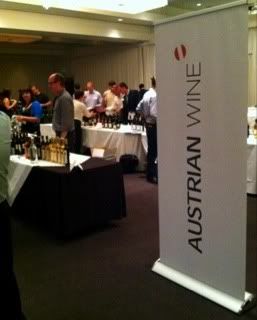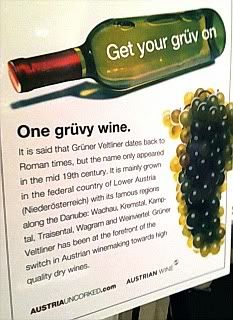Lodi, California never ceases to amaze me in its efforts to prove itself worthy of inclusion in the the Great Wine Region discussion. Generations upon generations of agriculture flows through the Mokelumne River, and the growers like to proudly stand in the delta dirt and talk about how Lodi wine has grown up. Lodi has worked tirelessly to throw off the "jug wine" perception, work that probably started when they rebranded themselves from the "Tokay Capital of the World" to the "Zinfandel Capital of the World." The Lodi wine industry stepped up so bravely that it was was recognized as Wine Region of the World by Wine Enthusiast magazine in 2015.
The folks at
LoCA, the Wines of Lodi, work with
Brandlive to periodically stage virtual tasting events designed to get a few dozen wine writers excited about the region’s wineries. They needn't try so hard - we are already excited about Lodi. So much so that the annual
Wine Blogger’s Conference 2016 is set to be held there in August.
The most recent virtual event focused on wines made from grapes in Lodi's noted Mokelumne Glen Vineyard. In case the word looks unfamiliar to you, or even if you think you have it figured out, Mokelumne is pronounced Mo-KUL-uh-me, according to the vineyard's website. Once again, the event was hosted on a video feed by
Stuart Spencer, owner and winemaker at St. Amant Winery and Program Manager at the Lodi Winegrape Commission. On either side of him were
Markus Niggli, winemaker at Borra Vineyards and Markus Wine Company and
Brett Koth, Vineyard Manager at Mokelumne Glen Vineyards. I was provided with samples of the wines for the purpose of the event.
Mokelumne Glen Vineyards is a small, family-owned vineyard specializing in grape varieties that originated in Germany and Austria. They are in the Lodi Appellation as well as the Mokelumne River sub-appellation.
There are more than 40 different grape varieties growing in their sandy, granitic soil, including Riesling, Kerner, Gewürztraminer, Zweigelt and Bacchus. The last one, I had never even heard of until this event introduced it to me. Their collection of vines is reported to be the largest gathering of German and Austrian grapes in the U.S.
Koth spoke knowledgeably on his grapes, while Niggli offered his take as a winemaker who uses their fruit regularly. The vineyard only sells their fruit to a handful of vintners, so Niggli feels fortunate to get his hands on some.
The grapes involved in this tasting are largely thought of as cool-climate grapes, while Lodi has a warm, Mediterranean climate. Koth told us, however, that it’s cooler than people think where his grapes grow because of the delta effect and the proximity to the river. “Temperature fluctuation is the key, “ to maintaining these varieties, he said. That and early picking to ensure the high acidity for which the grapes are known.
Holman Cellars Uncharted Bacchus 2015 $25
An earthy white wine, what could be better? Whites need to be earthy, I feel.
Terroir gives them character in a much more visceral way the with reds. Winemaker
Jason Holman is based in Napa, and the
Holman Cellars "micro-winery" produces wines in extremely small lots. They like to make great wines from forgotten grapes. Forgotten? As I said earlier, I never even knew about Bacchus before this.
The grape represents only 2% of Germany’s plantings, so it is apparently not that well-known even over there. They made 45 cases of this 100% varietal wine, which is about two barrels worth. The three days of skin contact is followed by stainless-steel fermentation.
It’s a pale wine and has an earthy lanolin note on the nose. There’s a waxy quality on the palate that fits well with the apricot and nutmeg shadings. The acidity is very good in this most unusual wine. I thought it reminded me somewhat of the Symphony grape, but more muscular and not as sweet.
Markus NIMMO Lodi White Wine 2014 $22
Markus is Niggli’s own label, and the name NIMMO originated from his time in Perth, Australia. When he was new there, he remembered his way home by making a word of the first letters of the streets he needed to travel to get there. Australia plays a big part in Niggli’s career - it’s where the Swiss native was bitten bu the wine bug.
This white wine is made from 71% Kerner grapes, 13% Gewurztraminer, 11% Riesling and 5% Bacchus, all from Mokelumne Glen Vineyards. It is fermented in 60% new oak and aged there for nine months. The alcohol sits at 13.8% abv
Gewurz and Riesling in oak? Brett was shocked when he heard Niggli’s plans for those grapes, but he says the winemaker convinced him to "get on board."
Native yeast “brings higher alcohol at lower brix,” says Niggli. He says he thinks of the Kerner grape as "the unknown," and was intrigued by it enough to use it as the base for this wine. Three days skin contact before vinification gives good color, made richer by the use of oak.
The pale golden straw color is appealing, while the nose certainly isn’t scaring anyone away. Clean earth notes define the apple, papaya and lime aromas beautifully. The palate shows off-dry pear, apple and Meyer lemon flavors on a bed of acidity. Finishing long, it’s the earth and citrus that stays around after the sip. The wine’s body makes it a lot more versatile that just "salads and sipping." Niggli recommends you pair it with anything off the grill.
Hatton Daniels Lodi Zweigelt 2015 $24
Hatton Daniels Wine Cellars is the result of several wine enthusiasts putting a winemaker’s skill to good use. The website shows that winemaker
Dan Fishman also creates the bottlings of the Donum Estate and Stemmler, but with Santa Rosa-based Hatton Daniels he works with small vineyards to produce elegant, focused wines.
The vintners say this Zweigelt is "vibrant and alive," and is "meant for drinking in large, glorious quantities." They also say it’s a zero-sulfur wine, which some claim prevents hangovers. They say they make "no claim in this regard, but further study is recommended." Only 72 cases were made.
This wine is a tart little blast of cool-climate German grape, grown in Lodi. The earth that shows on the nose is mind-blowing. Raspberry fruit, oh yeah. Coffee grounds? Yep. Cola? Mm hmm. Meat? There’s some of that. The palate shows just as savory and just as dark, with tart berries, black tea and pepper.
M2 Wines Belle Etoile Blanche 2014 $24
For those who didn’t take four years of French in high school, and for those who did but have forgotten most of it, Belle Etoile Blanche means "beautiful white star." The
m2 wines late-harvest dessert creation blends four German grape varieties grown in Mokelumne Glen Vineyard , 35% Rieslaner, 25% Weissburgunder, 20% Riesling and 20% Gewurztraminer. This wine is naturally sweet and is not fortified. Three months fermentation was accomplished half in neutral French oak barrels and half in a stainless steel tank. Alcohol is light, at 13.3% abv and there is less than 10% residual sugar.
Layne Montgomery is the winemaker, and he had the grapes picked as late as the first day of November and whole-cluster pressed to add character to the flavor. Koth notes that it’s the only sweet wine produced the grapes of his vineyard. The consensus seemed to be to pair this wine with any "stinky cheese" you prefer.
M2’s Belle Etoile Blanche is a delightful dessert wine that is pleasantly sweet without overdoing it. The nose is honey and apricots, while the palate shows a crisp and acidic palate that draws a line against cloying and stands well apart from it. The fruit is clean and ripe - certainly - and leaves a citrus and stone fruit finish after the sip. This will pair with cheese in a heartbeat or a fruit tart in about the same time.
Follow Randy Fuller on Twitter










 As is the case at wine tasting events where there is a proliferation of one particular type of wine, I experienced palate fatigue and the Gruner Veltliners all started to taste the same. I've experienced the same thing at events that were heavy on Pinot Noir, Tempranillo and Albarino. Mixing it up made for a good palate cleanser. I'd taste whites for a while, then reds, then back to whites. I even went across the property and sampled a few Ribera Tempranillos at another event going on at the same time. As good as those Spanish wines were, I didn't stay long. I couldn't wait to get back to Austria.
As is the case at wine tasting events where there is a proliferation of one particular type of wine, I experienced palate fatigue and the Gruner Veltliners all started to taste the same. I've experienced the same thing at events that were heavy on Pinot Noir, Tempranillo and Albarino. Mixing it up made for a good palate cleanser. I'd taste whites for a while, then reds, then back to whites. I even went across the property and sampled a few Ribera Tempranillos at another event going on at the same time. As good as those Spanish wines were, I didn't stay long. I couldn't wait to get back to Austria. As I mentioned earlier, the wines of
As I mentioned earlier, the wines of 